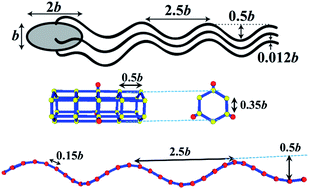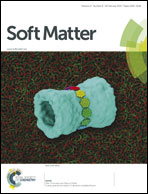A bead-spring model for running and tumbling of flagellated swimmers: detailed predictions compared to experimental data for E. coli†
Abstract
To study the swimming of the multi-flagellated bacterium Escherichia coli, we deploy a bead-spring hydrodynamic model (Watari and Larson 2010), whose body and flagellar geometry, motor torques, and motor reversals are adjusted to match the experimental observations of the Berg group (Turner et al. 2000; Darnton et al. 2007) during both running and tumbling of the bacterium. In this model, hydrodynamic interactions, which drive swimming, flagellar bundling, and unbundling during swimming and tumbling, are imposed by treating the beads as Stokeslets, imposing torques and counter-torques on the body and flagellum at the flexible joint connecting them to represent the action of motor, and using the Rotne–Prager tensor to model their hydrodynamic interactions with other beads. We explore the behavior of coarse-grained (60-bead) and refined (120-bead) versions of the model, and show that predictions of running speed, helical and body rotation rates, body wobble rates and angles, average tumbling angles, range of tumbling angles, and flagellar re-bundling times are in good agreement with experimental observations by Berg and coworkers. We find that variation in tumbling angle arises from variation in flagellar number and location on the bacterial body, variations in polymorphic transitions of the filaments, and especially from variations in the duration of the tumbling time, which is roughly linearly correlated with tumbling time up to tumbling angles of around 40–50° and more weakly thereafter. The accuracy of the model suggests its usefulness for future studies of swimming of other flagellated swimmers, for predictions of collective phenomena, and for tuning parameters of coarser-grained swimmer models to achieve greater realism.


 Please wait while we load your content...
Please wait while we load your content...